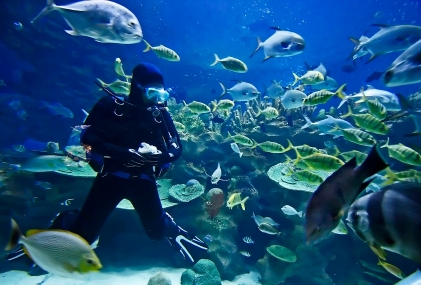Biodiversity
Scenario

For your work on the United States Panel on Global Climate Change Research, you and your team of ecologists and environmental scientists have been studying some of the most exotic places on Earth.
Team members have scuba-dived around massive, colorful coral reefs, studied deep ocean water onboard submersibles, hiked through rainforests, and taken samples of grassland soils in Kansas and the Zambezi River basin in Africa.
Your major task has been to study Earth’s biodiversity and its importance. Biodiversity is the number of different kinds of plant and animal species in a natural environment.
With a major international conference looming, you must now apply climate change information and the data you collected to make a prediction about the world 30 years from now. Your colleagues are gathered to share their experiences and their preliminary findings with the rest of your group.
This International Panel on Climate Change conference requires more than a standard report citing data and displaying results in tables and graphs. Thorough analysis of the data is required to present an accurate picture of Earth’s biodiversity. Climate changes have been the focus of heated controversy and debate for the last decade. As a scientist, you naturally look at the data from purely objective perspectives.
An important element of the ongoing research on global climate change is the study of how climate changes may affect biodiversity. Understanding the mechanisms behind potential climate changes will allow you to make accurate predictions of the impacts to organisms because of resulting environmental changes.
Your team is tasked with researching the predicted climate changes and the corresponding impact, if any, that the changes will have on biodiversity. Your team must report both the changes and consequences. Once an accurate assessment is made, the panel can move on to resolutions that may alleviate any negative impacts.
Task
Predict and describe what Earth’s biodiversity will be 30 years from now.
In order to present accurate, complete, and valid findings, you should consider the following:
-
What do the data indicate about Earth’s biodiversity? Identify any trends that occurred in biodiversity.
Think “before and after” to help you identify a big picture of the biodiversity on Earth and the changes that may have occurred over decades.
-
What are the impacts of changes to Earth’s physical environments on species diversity? Remember to report the impacts to humans, wildlife, ecosystems, etc.
How are Earth’s environments changing? How does this affect species diversity?
-
What appears to be the source(s) of the changes? Can you identify a major cause?
This is very important to understanding the mechanisms that drive the change and, therefore, important to finding a possible remediation of the impacts.
-
What are the impacts of changes in Earth’s biodiversity?
Potential impacts of changes in Earth’s biodiversity are serious. Consider all impacts, not only to those species directly affected, but to those that might be affected as a consequence. The International Panel on Climate Change will need to know impending impacts in order to plan for the future.
-
What strategies do you see that could mitigate or lessen decreased species diversity? How long would the strategies take to make a difference?
Remember:
Some members of the panel have already discussed some questions in addition to those above. Be prepared to answer the following:
- If environments lose species, will other species take their place?
- Describe the mass extinctions in Earth’s history. How are these similar or different from today’s extinctions?
- If the environment changes, it may no longer be optimal for some existing species, but it may be beneficial to other species. Why isn’t this necessarily a good situation?



